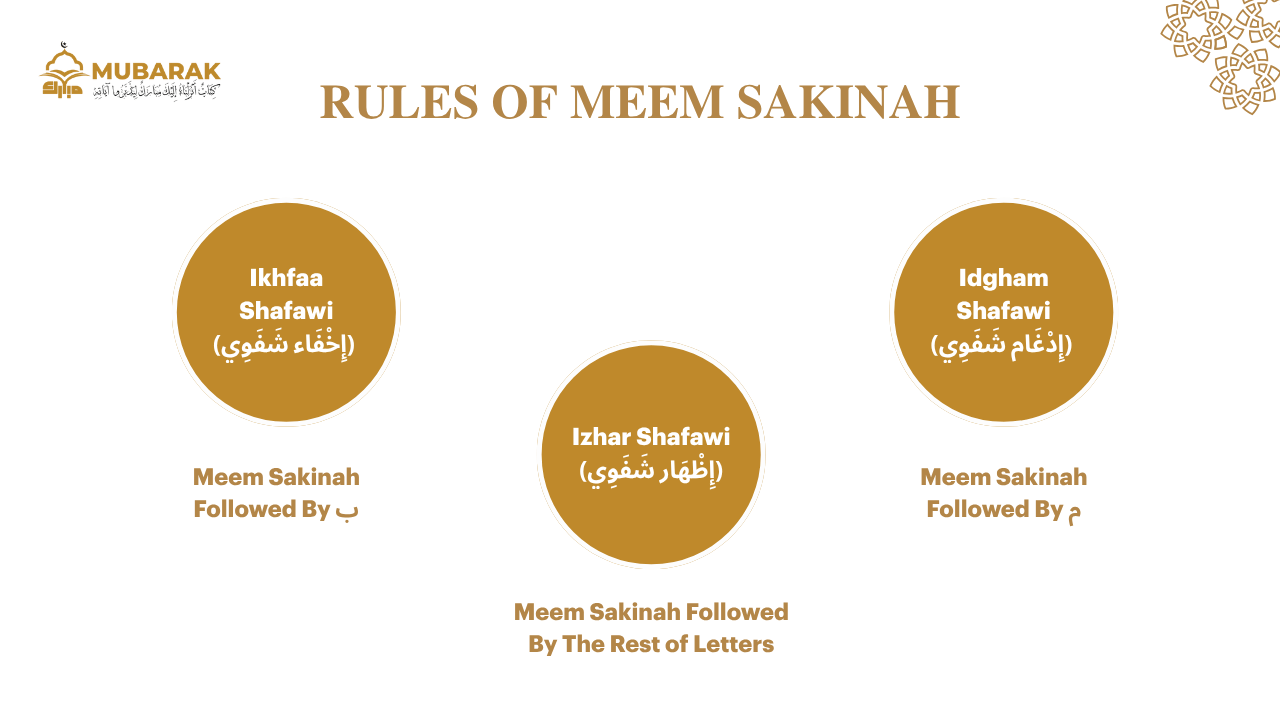Accurate pronunciation, beautiful voice, and avoiding mistakes during reciting the Quran can be achieved once you excel at the Tajweed rules. You have a chance now to learn one of the ultimate guidelines of Quran reciting: Rules of Meem Sakinah that enables you to articulate and pronounce the Quranic text efficiently. In this blog, you will learn the three rules of Meem Sakinah and how to apply them effortlessly to ensure familiarity.
What Is Meem Sakinah?
Meem Sakinah (مّيمْ سَاكِنَة) is this Meem that bears a sukoon over it, which means it’s not a vowel letter. For instance: تَرْمِيهِمْ Hence, some rules of Meem Sakinah govern your recitation to sound natural and recite the holy Quran as it was revealed.
Three Rules of Meem Sakinah (Ikhfa, Idgham, Izhar)

The rules of Meem Sakinah can be the easiest rules you come across while learning Tajweed if you follow theoretical knowledge with practice and consistent training. They are just three rules, their names are like those of Rules of Noon Sakinah and Tanween however, they are not the same.
1. Ikhfaa Shafawi (إِخْفَاء شَفَوِي)
Ikhfaa Shafawi occurs when Meem Sakinah is followed by the letter Baa (ب). Ikhfaa means concealing, we must softly conceal the Meem sound in part and mix it with the Baa sound. Pronounce it by hiding the Meem sound as it partly transitions into the letter Baa, with a small Ghunnah. This sound should be for two counts, or Harakaat.
Quranic Examples:
سَلْهُم أَيُّهُم بِـذَلِكَ زَعِيمٌ﴾( القلم 40)﴿
لَّسْتَ عَلَيْهِم بِـمُصَيْطِرٍ﴾ ( الغاشية 22)﴿
أَلَمْ يَعْلَم بِـأَنَّ اللَّهَ يَرَى﴾ ( العلق 14)﴿
وَمَا صَاحِبُكُم بِـمَجْنُونٍ﴾ ( التكوير 22)﴿
2. Idgham Shafawi (إِدْغَام شَفَوِي)
The word Idgham means merging. Once you see a Meem Saakin is followed by another Meem (م), but the second Meem is a vowel bearing Fattaha, Dammah, or Kassrah, you merge them together saying one Meem with the prolonged nasal sound. This rule has been considered the easiest one of the rules of Meem Sakinah as all you need to do when you see two Meems and the first one is Sakinah to combine them with a nasal tone that lasts for two counts, such a seamless blending!
Quranic Examples:
إِنَّهَا عَلَيْهِم مُّؤْصَدَةٌ﴾ (الهمزة 8)﴿
يُرْسِلِ السَّمَاء عَلَيْكُم مِّدْرَاراً﴾ (نوح 11)﴿
وَاللَّهُ أَنبَتَكُم مِّنَ الْأَرْضِ نَبَاتاً﴾ (نوح 17)﴿
الَّذِي أَطْعَمَهُم مِّن جُوعٍ وَآمَنَهُم مِّنْ خَوْفٍ﴾ (قريش 4)﴿
3. Izhar Shafawi (إِظْهَار شَفَوِي)
Izhar Shafawi means making the Meem clear, occurring when the Meem Sakinha comes at the end of a word and followed by any letter excluding the Baa ب or another Meem. Therefore, this rule is applied to 26 letters of the Arabic alphabet, in which we articulate the sound of the Meem clearly without Idgham or Ikhfaa.
Quranic Examples:
لَكُمْ دِينُكُمْ وَلِيَ دِينِ﴾ ( الكافرون 6)﴿
خَتَمَ اللّهُ عَلَى قُلُوبِهمْ وَعَلَى سَمْعِهِمْ وَعَلَى أَبْصَارِهِمْ غِشَاوَةٌ وَلَهُمْ عَذَابٌ عظِيمٌ﴾ (البقرة 7)﴿
خَاشِعَةً أَبْصَارُهُمْ تَـرْهَقُهُمْ ذِلَّةٌ وَقَدْ كَانُوا يُدْعَوْنَ إِلَى السُّجُودِ وَهُمْ سَالِمُونَ﴾ (القلم 43)﴿
نَحْنُ خَلَقْنَاهُمْ وَشَدَدْنَا أَسْرَهُمْ وَإِذَا شِئْنَا بَدَّلْنَا أَمْثَـالَهُمْ تَـبْدِيلاً﴾ (الانسان 28)﴿
How to Apply Rules of Meem Sakinah in Recitation
The rules of Meem Sakinah are essential for proper Tajweed and Quranic recitation, mastering it if you sincerely intend to do that exquisitely for the sake of Allah, just with some tips you can achieve that effortlessly:
1. Don’t Rush
You can’t apply the rules of Meem Sakinah without a good grasp of them. So, the first step should be watching a detailed explanation of them without rushing. You need to learn how these rules are applied based on the following letter and memorizing such letters well to be able to distinguish the rule.
Mubarak Academy is the best Online Quran academy that can provide you with comprehensive courses to ensure better and clearer understanding.
2. Practice Makes Perfect
Getting only a background is not sufficient to make you recite the holy Quran properly, it must be coupled with regular practice to test your knowledge and ability to use the rules of Meem Sakinah. You should recite verses containing Meem Sakinah from day one when you start learning this lesson.
3. Seek Feedback from Professionals
Getting feedback and correcting your mistakes is the best way to ensure a successful learning process. The feedback is crucial to figure out you are applying the rules right or wrong, as we can’t hear ourselves. So, we may think we pronounce correctly while it’s contrary to that.
4. Enhance your Skills by Listening
A tip costs you nothing and guarantees a great improvement. Just put on your headphones and listen to expert reciters to train your ear and brain to the right pronunciation. Pay your full attention to their use of rules of Meem Sakinah and how they apply them with clarity and the right nasal sound in the recitation.
Most importantly, be aware that you seek a learning pathway that requires time and effort, so don’t give up or get bored with practicing and trying. Making mistakes and practicing are key elements of the learning process.

Conclusion
Every Muslim should recite the Quran correctly, gaining proficiency in the rules of Meem Sakinah improves your recitation leading to better spiritual experience and feeling the Quran’s beauty. Start now and check our Tajweed Quran Online course to ensure your recitation adheres to Tajweed’s principles.
Recommended Courses:
- Quran Memorization Course
- Tajweed Quran Online Course
- Islamic Studies Course
- Arabic Language Course
- Quran Ijazah Course
Frequently Asked Questions
1. What are Saakin letters in Tajweed?
Saakin letters that are silent or without a vowel, which means the letter does not bear a short vowel (Fatha, Damma, or Kasra.)
2. Why Should I Learn the Rules of Meem Sakinah?
To correctly recite the Quran as it was revealed on our Prophet Muhamed (PBUH) and enhance your recitation’s beauty and spiritual elevation. Pluse, avoid the common mistakes that are raised from the lack of Tajweed knowledge.
3. Are Noon Sakinah and Meem Simillare in rules?
The laws that control the Noon are similar to those of the Meem, both should be silent and the following letters determine the case.
4. Does Ikhfaa Need Ghuna?
Yes, it is essential to produce the nasal sound of Ghuna while concealing the letter Meem when it is followed directly by Baa.




